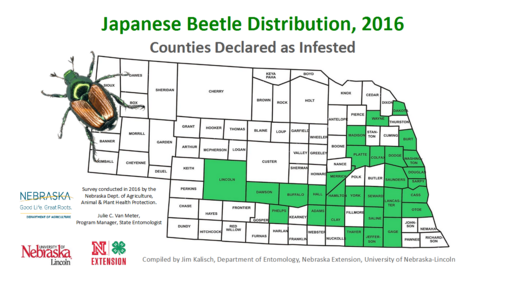
- The distribution (Figure 1) of Japanese beetles has been increasing over the past few years and they are being found more frequently in corn and soybean fields.
- Adult Japanese beetles have one generation per year and typically begin emerging in mid-June and continue for several weeks.
- Japanese beetles can sometimes be confused with false Japanese beetle or sand chafer. The sand chafer is native to Nebraska and typically found along the Platte River valley and other valleys.
- The Japanese beetle is similar in size to the sand chafer; however, Japanese beetles have a metallic green head and white tufts of hair along their abdomen (Figure 2).
- Adults typically feed in clusters due to sex pheromones given off by females and volatiles emitted by damaged plants.
- In corn adults will defoliate leaves but economic losses usually occur due to extensive silk clipping.
- In soybeans yield losses are typically attributed to adults skeletonizing soybean leaves.
- In soybeans insecticide applications are recommended when leaf defoliation exceeds 30% during the vegetative stage and 20% during the reproductive stage.
- Additional information can be found in Managing Soybean Defoliators, NebGuide G2259.
- The University of Illinois Extension recommends that corn ears with three or more Japanese beetles, silks clipped to less than ½ inch, and pollination at less than 50% completion should consider an insecticide application.
- Japanese beetles are not equally distributed in fields; the highest populations occur at the field margins.
- Information on insecticide options is available in the Guide for Weed, Disease and Insect Management, Nebraska Extension EC130.

